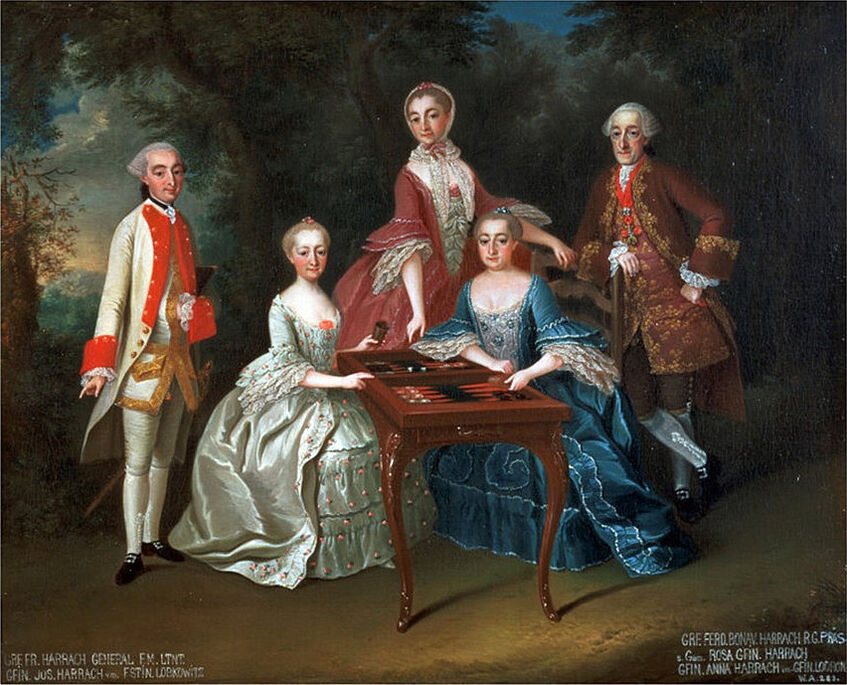Noble Siblings. Wealth Arrangements & Social Configurations

Family portrait of the Harrach lineage, 1755. Depicted are (from left to right) the siblings Franz Xaver von Harrach (1732-1781), Maria Josephina von Liechtenstein (1727-1788), Maria Rosa von Harrach (1721-1785) and Maria Anna von Lodron (1725-1780). On the far right is Ferdinand Bonaventura von Harrach (1708-1778), the paternal uncle of the four nobles.
Picture from: de.wikipedia.org/wiki/Harrach
Current project

Current project
Principal investigator: Prof. Dr. Margareth Lanzinger
Project team members:
Florian Andretsch MA
Claudia Rapberger MA
Project duration: October 2024 - September 2026
Project number: FWF - PAT 3819724
In the preceding project (for a description see below), we investigated wealth arrangements in Austrian noble families in the Early Modern Era as well as their impact on life paths and sibling relations. The current project inspects the research questions of the preceding project on the basis of a larger set of sources and cases. Furthermore, both sub-projects will deepen inquiries into three topics which have proven themselves to be important and worthy of deepened research.
Firstly, we study more intensively how siblings cooperated in different offices and positions. Traditionally, the shift towards primogeniture is perceived to be a process especially prone to conflict. However, quarrels between siblings were rare among the families which we have analysed, mutual support was frequent and differences between the life paths of younger and older siblings existed prior to the introduction of primogeniture. To understand early modern sibling relations, it is thus more fruitful to ask when and how siblings helped each other than to focus on conflictual situations. Secondly, we investigate more strongly into the activities of noble widows. In nearly all cases we analysed they had a lot of power and wealth. Not rarely, they administered estates of their deceased husbands as guardians, recipients of bequests or as mortgage creditors. Their influence made them important allies for brothers and sisters and they often influenced relationships among their children. They are, thus, of special importance to our project. Thirdly, we currently put efforts into better understanding the role of debt and credit on sibling relations. Debt relations could arise due to inheritance related negotiations when inheritance portions or compensatory payments could not be payed in cash immediately. Beyond inheritances, siblings were often financially connected because they frequently lent much money to each other. Brothers and sisters were also important when one had to find creditors outside the family or when one had to deal with discontent lenders. This economic dimension of sibling relations merits closer analysis.
Preceding project

Preceding project
Project duration: October 2021 - September 2024
Project number: FWF - P 34762-G
In early modern times, connections and relationships to family members and relatives determined the social position as well as the opportunities of a given individual to a great extent. Family and kinship were particularly important within the aristocratic milieu. Noblemen and -women distributed wealth and power along lines of descent and marriage and often codetermined the life paths of fellow members of their "lineage" to a significant degree. Usually, children had to follow the plans of their parents or other high-ranking relatives. What was at stake was the succession of property, careers in clerical, diplomatic, and military offices or functions, as well as favorable marriage connections. Distinctions made on the basis of gender and birth order greatly impacted the distribution of such positions. But behind structural guidelines of this kind stood men and women with their own interests, desires and ideas that determined their actions.
Recent studies assume that the organization of families and kin groups within powerful and wealthy social classes changed fundamentally in the early modern period (ca. 1500-1800). Novel inheritance practices favoring the eldest son of a given family created new, more authoritarian family forms. The project investigates the structure of kinship relationships - especially between siblings - within a familial organisation that seems to have produced such significant inequalities between family members.
The research project analyzes the familial and kinship relations within the nobility of the Habsburg monarchy during this crucial period. The two Sub-Projects thus aim to provide a detailed and nuanced understanding of the inner workings of families and kin groups in times of radical change and to contribute to our understanding of how members of the Habsburg Empire's elite used connections formed by descent and marriage to monopolize positions of wealth and power. For this purpose, the project combines different research perspectives and utilizes a diverse corpus of sources. The study focuses on the four noble families Lamberg, Starhemberg, Trauttmansdorff and Harrach.
